The Fourth Edition
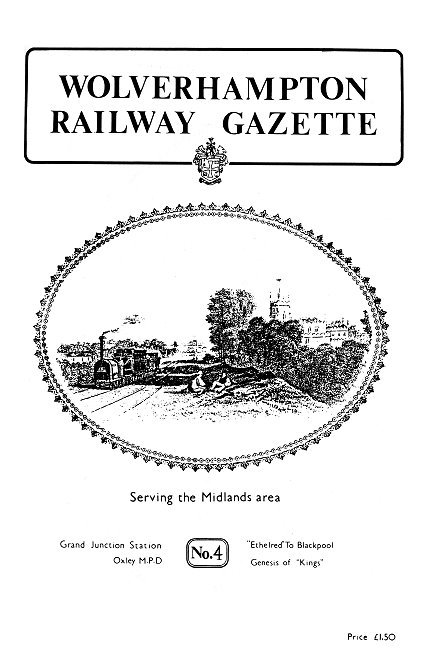 |
This edition includes articles on Wolverhampton's first
station, 'King' Class locomotives, a '2021' class saddle tank, railway
reminiscences - 'Sins of Our Fathers', H.C. Casserley's visit to
Wolverhampton, and engine workings in the Stourbridge area.
'Wolverhampton's first station' is a description of Wednesfield Heath
station on the Grand Junction Railway. 'King Class locomotives'
describes some of the excellent performances of Stafford Road engines
and 'A Visit to Wolverhampton' is an account of H.C. Casserley's visit
to Stafford Road Works. It is well illustrated with a number of
photographs of the engines that were there at the time.
The cover picture shows a Grand Junction Railway mixed train passing
through Penkridge. |
Oxley Locomotive Sheds 1907
- 1967
| In the Victorian period the running sheds at Stafford Road had served
for the maintenance of all Wolverhampton based G.W.R. locomotives. In
1905 the directors of the company authorised the building of a separate
shed for goods engines across the viaduct at Oxley sidings. The building
contract was approved in March 1906 and the operations were put in
charge of the company’s newly appointed works engineer, Mr. Walter
Armstrong, the resident engineer being Mr. W.E. Hart. The building
contractors were the local firm of H. Lovatts. |
|
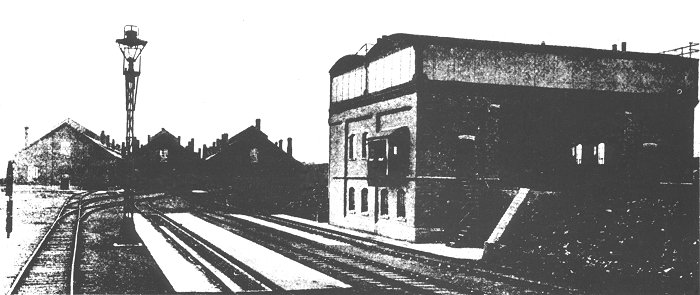
Oxley prior to opening. |
| The shed was situated on the down side of the line
adjacent to the already long established goods sidings. The design
of the shed building followed the standard Swindon pattern, except
that space dictated the placing of the interior turntables one
behind the other. The design allowed for the installation of at
least a further two turntables at a future date. In the event such an enlargement was never required. The turntables
were each 65 feet in length, with under support girders. Both were
encircled by 28 inspection pits, varying from 41 to 100 feet in length. On the left of the main shed building was the engine
lifting shop, with the foreman’s and administration clerk's offices
on the right. At the northern side were the enginemen, mechanics and
cleaners room (with kitchen) and the lavatories. A standard sand
furnace was also provided. The gloom within the shed was partly
dispelled by the large nine burner gas lamps, suspended from the
roof. |
|
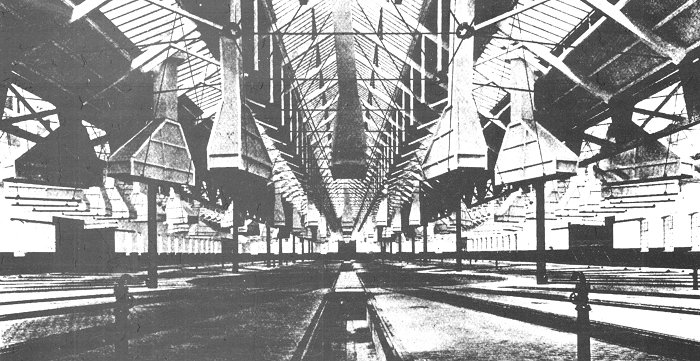
Oxley interior. |
| Whilst a number of tall gas lamp standards provided for the shed yard.
The sheds and yard were provided with electricity in the 1950's. Although Oxley was primarily built as a goods and
shunting engine depot, various mixed traffic locomotives were
shedded there from the mid 1930s onwards. When Stafford Road closed
in 1963 its allocation of express engines was transferred to Oxley.
The shed code ‘OXY’ became ‘84B’ on Nationalisation and was recoded
to ‘2B’ in September 1963.
|
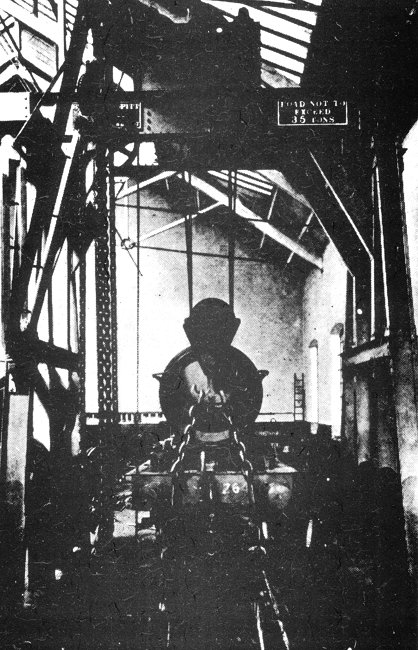
Oxley lifting bay when new. The hoist is
seen here in its manual days, being later electrified. It had a 35
ton capacity with a clear lift of 19 feet. To this was fitted a 6
ton swinging jib crane for lighter loadings. The service tools were
also kept here, the place being spotlessly clean in G.W.R. days. |
In the 1960s the ex G.W.R. locomotives were disappearing
rapidly, being replaced by increasingly grimy and run-down ex
L.M.S. or B.R. standard classes.
The yard at the rear of the
shed became a dumping ground for derelict engines of all sorts,
which were promptly vandalised by souvenir hunters. The shed
interior too was a far cry from the halcyon days of the past.
The regular weekend cleaning of walls, floors and fittings had
long since ceased. The huge smoke chutes that carried the engine
smog away to the outside world had rotted away, and in some
cases collapsed to the ground. The smoke then took to hanging
about in the roof, turning all it touched to a sooty black.
The
floors were thick with dangerous black grease. The shed formally
closed in March 1967, though steam engines found their way there
until the late summer, receiving minor running repairs. The
place gradually became derelict, and was dismantled for its Randley red bricks, which were considered too useful to throw
away. |
|
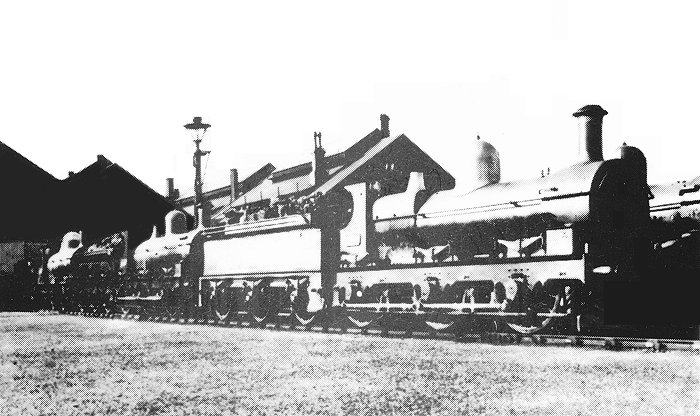
Oxley, 1910. Armstrong goods 0-6-0. numbers
406 and 1015 are in the foreground. |
| The unwanted remains were bulldozed beyond the rear
of the old shed, forming a bed for the new carriage cleaning depot,
soon to be built on the site. The rubble is still there, including
some of the green enamelled light shades that once hung inside the
main building. The approach roads that once formed the shed running
yard now serve the carriage cleaning depot, which stands on the site
of the former shed. |
|
OXLEY principal
dimensions |
| Lifting shop
84'0" x 58'6" |
Stores (including office)
72'0" x 56'6" |
| Mess rooms
146'6" x 15'6" |
Lavatories
30'0" x 15'6" |
| Sand furnace
50'0" x 25'6" |
Coal stage
52'0" x 59'6" |
| Tank capacity
145,000 gallons |
|
| Total area of buildings
98,960 square feet |
|

|
|

|
|

|
| Return to
Edition 3 |
|
Return to
the Beginning |
|
Proceed to
Edition 5 |
|